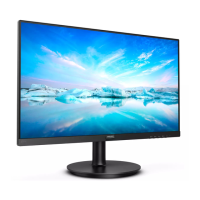
Do you have a question about the Philips V line 271V8 and is the answer not in the manual?
| Screen Size | 27 inches |
|---|---|
| Resolution | 1920 x 1080 (Full HD) |
| Panel Type | VA |
| Refresh Rate | 75 Hz |
| Aspect Ratio | 16:9 |
| Brightness | 250 cd/m² |
| Contrast Ratio | 3000:1 |
| Viewing Angle | 178° (H) / 178° (V) |
| VESA Mount | 100 x 100 mm |
| Color Support | 16.7 Million Colors |
| Connectivity | HDMI, VGA |
| Response Time | 4 ms (GtG) |
Essential safety guidelines and maintenance procedures for proper monitor operation and longevity.
Explains the meaning of icons and text formatting conventions used in the manual.
Guidelines for environmentally responsible disposal of the monitor and its packaging.
Step-by-step guide for unpacking and physically installing the monitor components.
Instructions on how to connect the monitor to a computer system using various cables.
Overview and explanation of the monitor's control buttons for adjustments and functions.
Detailed explanation of the On-Screen Display (OSD) menu structure and options.
Instructions for removing the monitor base for VESA wall mount compatibility.
Features and benefits of Philips' SmartImage technology for optimizing display content.
Unique technology that optimizes monitor contrast ratio for visual clarity and viewing enjoyment.
Details on monitor panel type, resolution, refresh rate, colors, and other display characteristics.
Information about available input signals and audio in/out ports.
Details on user convenience features like OSD languages, VESA mount, and Kensington lock.
Information regarding the monitor's stand capabilities, including tilt.
Power usage figures for different operating modes and voltage inputs for both monitor models.
Physical dimensions and weight of the monitor with and without stand, and packaged.
Specifies the recommended temperature, humidity, and pressure ranges for operation and non-operation.
Information on RoHS, packaging, specific substances, and regulatory approvals.
Details about the monitor's cabinet color and surface finish.
Specifies the highest supported resolution and refresh rates for analog and digital inputs.
Advises on the optimal resolution and refresh rate for the best display quality.
Explains power saving features, definitions, and LED indicators for different power states.
Defines Philips' policy on acceptable levels of pixel and sub-pixel defects for warranty claims.
Describes and illustrates different types of pixel and sub-pixel defects like bright and black dots.
Discusses how the proximity of defects affects noticeability and tolerances.
Lists the acceptable defect levels for qualifying for warranty repair or replacement.
Specifies the maximum number of bright dot defects allowed before a monitor is considered defective.
Specifies the maximum number of black dot defects allowed before a monitor is considered defective.
Specifies the total acceptable number of bright and black dot defects for warranty service.
Details on purchasing and terms of extended warranty service packages.
Information on how to contact Philips customer service for support and inquiries.
Solutions for issues where the monitor power LED is not lit or is white.
Troubleshooting steps for issues like screen not centered or image vibrating.
Solutions for image centering, vibration, and vertical flicker issues.
Troubleshooting for horizontal flicker, blurred images, and distorted text.
Explains burn-in, after-image, ghost image phenomena and prevention methods.
Solutions for the 'Cannot display this video mode' error message.
Information on recommended refresh rates and installing monitor drivers.
Advice on screen scratch resistance and proper cleaning methods.
Instructions on how to adjust color temperature and other color settings via OSD.
Information on connecting to PCs, Macs, and Plug-and-Play compatibility.
Explains image sticking, burn-in, after-image, ghost image phenomena and prevention.
Advice on achieving sharp text and avoiding jagged characters by using native resolution.
Instructions on how to lock and unlock monitor controls using the hotkey.